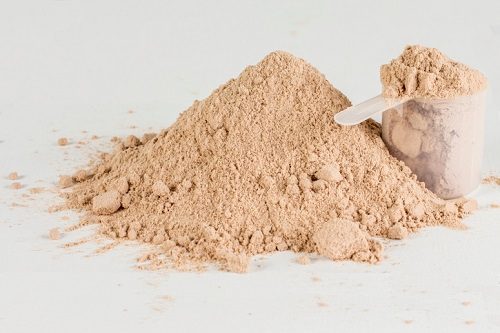
High-protein diets are all the rage these days, to go along with the gym-enthusiast lifestyle that many people are taking on. Protein is a macronutrient that is needed in the body for varying functions; in a sense it is a jack of all trades.
Protein and Your Body
Protein works as a building block for nearly every tissue, hormone, enzyme and transporter in the body (1). One’s daily protein requirement is based on weight and activity level; for the average healthy adult of either gender, the requirement is about 0.8 grams of protein for every kilogram of body weight (1). For people looking to build muscle mass and serious athletes, the requirement is upped to 1.4–2.0 grams per kilogram (1).
Regardless of individual goals, everyone should get enoough protein in their diet to maintain body mass and functionality across all systems.
Protein for Athletes
During resistance training, the goal is to push your muscle to the limit, and this can cause trauma or tearing to the muscle fibers. When a muscle fiber is torn, a signal is sent to the surrounding cells, and there is a communal effort to repair and rebuild the injured muscle, which eventually leads to an increased thickness of muscle fibers known as muscle hypertrophy (2). Following trauma to the muscle fiber, branched chain amino acids (BCAAs), particularly leucine, have been found to work synergistically with exercise to increase the response made by the body and increase muscle growth (3).
BCAAs are the basis for protein synthesis and energy production and can make up nearly one-third of skeletal muscle protein (4). BCAAs are not synthesized in the body, and therefore must be obtained in the diet (5). Athletes and workout enthusiasts use this knowledge as the basis for adding protein supplements to their diets in hopes of achieving a more impressive physique.
What to Take
There are multiple forms of protein available. Casein and whey are the most common and can be seen in dozens of brands, flavors and combinations. Milk proteins are complete proteins, meaning they contain all 21 essential amino acids needed for protein maintenance and synthesis in the body. When comparing the difference between whey and casein, look at the absorption rate as well as the content of the individual products and what they will specifically do in the body.
Whey is absorbed more quickly and contains more leucine while casein is higher in glutamine (6). Leucine is essential for activating skeletal muscle synthesis and is thought to increase lean body mass (6). It is estimated that for muscle mass to increase, the body may require as much as 12 grams of leucine per day; making whey, at 26% BCAA, a good choice for some looking for a “fast protein” (7). Glutamine on the other hand also contributes to muscle growth by increasing growth hormone concentrations which lead to muscle anabolism (7).
Meanwhile, isolated soy protein peaks more slowly than whey protein, but stays in the body longer.
For non-dairy protein supplementation, pea proteins have become increasingly popular, and for good reason. Peas are particularly ideal for people with food allergies because they are not considered a major allergen; it is also a good substitute for those looking for better digestibility (8). Pea protein helps people have a pre-workout energy boost as well as the benefits of improved post-workout recovery. What makes this option popular is that it has a protein profile that closely resembles whey protein (8). On the list of pea protein amino acids are BCAAs leucine, isoleucine, valine, arginine, lysine and glutamine (8). This option is easy on the stomach, and is a great for individuals with lactose intolerance or a soy allergy.
Other plant-based proteins include blends of ingredients like sacha inchi seed, hemp, cranberry and brown rice.
Time for Protein
Lastly, when is the best time to take protein supplements? As mentioned, immediately after a workout, the muscles have undergone some trauma leaving the body in a net negative protein balance. During this time, you are essentially in a state of recovery and protein is needed to repair and rebuild. A post-workout shake will aid in getting your body back to an anabolic state and restore a positive protein balance resulting in increased muscle hypertrophy (9). WF
References
1. L. Sherwood, Human Physiology: From Cells to Systems (Belmont, CA, Brooks/Cole, CENGAGE Learning, 2010).
2. Y. sub Kwon and L. Kravitz, “How Do Muscles Grow?” www.unm.edu/~lkravitz/Article folder/musclesgrowLK.html, accessed May 9, 2014.
3. H. Nicastro, “Does Branched-Chain Amino Acids Supplementation Modulate Skeletal Muscle Remodeling through Inflammation Modulation? Possible Mechanisms of Action,” J. Nutr. Metabolism, Vol. 2012 (2012).
4. R. Andrews, “All About BCAA,” www.precisionnutrition.com/all-about-bcaas, accessed May 9, 2014.
5. A. Tom and K.S. Nair, “Assessment of Branched-Chain Amino Acid Status and Potential for Biomarkers,” J. Nutr. 136 (1), 3245–3305 (2006).
6. H. Kollias, “Protein Supplements: Are You Even Absorbing Yours?” www.precisionnutrition.com/rr-whey-too-much, accessed May 9, 2014.
7. H. Kollias, “Research Review: Fast vs. Slow Whey for Protein Synthesis,” www.precisionnutrition.com/whey-vs-casein, accessed May 9, 2014.
8. “Why Using the Same Protein Mix Every Morning for Breakfast May Not be a Wise Thing to Do...” http://proteinpowder.mercola.com/Pea-Protein.html, accessed May 9, 2014.
9. C. Poole, et al., “The Role of Post-Exercise Nutrient Administration on Muscle Protein Synthesis and Glycogen Synthesis,” J. Sports Sci. Med. 9. 354–363 (2010).
Published in WholeFoods Magazine, June 2014










